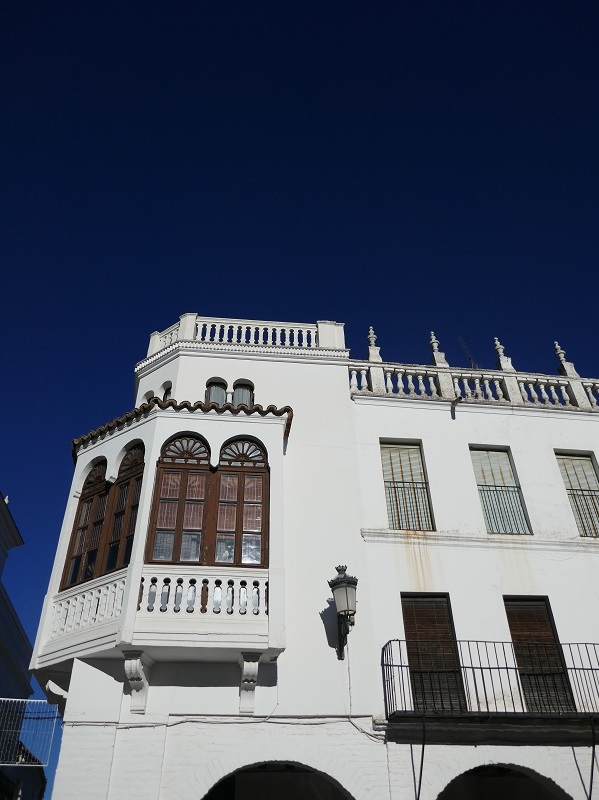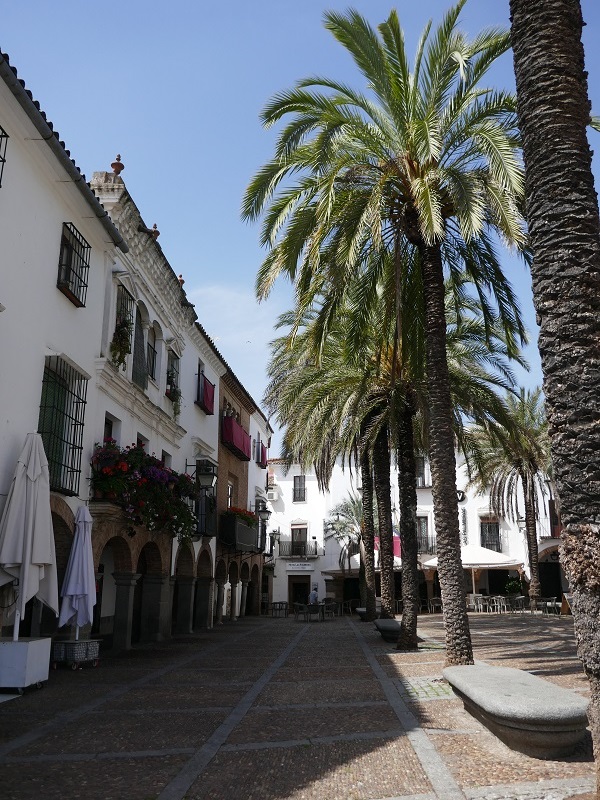(Last updated on 13/10/2025)
Traditionally built as centres of local communities, squares help enormously shape the identity of cities, towns and villages. Spanish plazas often are where locals meet, drink, and relax, and where many festivals, markets and other events take place.
In this article, I share some of the most beautiful squares in Extremadura that you shouldn’t miss, and what’s special about them.

Table of contents
- 1 Plaza Alta, Badajoz
- 2 Plaza Mayor, Cáceres
- 3 Plaza Mayor, Trujillo
- 4 Plaza de España, Llerena
- 5 Plaza de la Constitución, Garrovillas de Alconétar
- 6 Plaza de la Fuente de los Chorros, Cuacos de Yuste
- 7 Plaza de España, Valverde de la Vera
- 8 Plaza Grande, Zafra
- 9 Plaza de España, Mérida
- 10 Map of beautiful squares in Extremadura
Plaza Alta, Badajoz
A former souk in Moorish times and a market square in medieval times, Plaza Alta is a popular meeting place for locals and a regular venue for concerts, music festivals and other events. This charming porticoed square has two distinct and easily distinguishable areas: the oldest area to the north (along the citadel), with facades painted in soft brown and white, is home to the former town hall; the southern (newer) side of the square displays a striking red, dark grey and white geometrical pattern façade.



Plaza Mayor, Cáceres
Plaza Mayor is surrounded mostly by porticoed buildings including bars, restaurants, hotels, flats and several local administrative buildings such as the City Hall. But it’s the oldest, eastern side of the square where the main historical highlights are located, namely two twelfth-century towers, a pretty thirteenth-century church (Ermita de la Paz), and part of the city walls. The beautiful Arco de la Estrella at the top of the central stairs serves as the gateway to the Old Town of Cáceres, a World Heritage Site. Today, the square hosts Easter celebrations, markets, and music and dance events such as the renown WOMAD festival.



Plaza Mayor, Trujillo
Trujillo’s Plaza Mayor frequently features in travel publications as one of Spain’s most beautiful squares. Dominated by an equestrian statue of Trujillo-born Francisco Pizarro, the main square is where guided tours usually start and end, and where the main local festivities and celebrations take place. Take your time to walk around the square, which is lined with restaurants, public buildings and very grand palaces. Particularly notable are the Palacio de los Marqueses de la Conquista (temporarily home to the Oficina de Turismo), and the Palacio de Piedras Albas.



Plaza de España, Llerena
The multi-style look of this large porticoed square reflects the many different uses that the square has had over the centuries – from a weekly market to bullfights, religious processions, public executions by the Spanish Inquisition, and more joyful events such as fairs. Plaza de España is dominated Iglesia Nuestra Señora de la Granada, an impressive church with a peculiar two-level Mudéjar gallery. Other notable architectural elements include the large porticoed gallery on the northwestern side of the square, the town hall (Palacio Consistorial) and a hexagonal seventeenth-century water fountain, designed by renown painter Francisco de Zurbarán.



Plaza de la Constitución, Garrovillas de Alconétar
This porticoed square was built in the fifteenth and sixteenth centuries as a market and trade square, with ground-floor guesthouses welcoming traders passing through. The quirky look of its wonky columns is a result of the 1755 Lisbon earthquake that strongly affected areas of Spain. The main highlights in Plaza de la Constitución are the Hospedería Puente de Alconétar, a fifteenth-century Renaissance-style former palace-turned hotel, and the corral de comedias – a working theatre built in the style of classic Golden Age playhouses.



Plaza de la Fuente de los Chorros, Cuacos de Yuste
Good things come in threes, and in Cuacos, it’s about squares. Perhaps playing second fiddle to Plaza de España and Plaza de Juan de Austria, this irregular little square is a must-see for the visitor. It radiates rural charm, with the sound of water gushing out of a nice stone fountain as a background to a bucolic village scene of half-timbered houses, a profusion of flowerpots and a stunning stone house on the corner.



Plaza de España, Valverde de la Vera
Valverde de la Vera is easily one of the most charming villages in La Vera area, evidenced by its quaint main square. Water is a regular feature in squares generally, with a stone fountain occupying centre stage, but in Valverde this is topped up by an open-air stream running along the eastern side of the plaza. Everywhere you look, you’ll see traditional verato-style architecture, with houses displaying pretty wooden balconies and exposed beams, many of them supported by granite columns.


Plaza Grande, Zafra
Zafra has two noteworthy squares – a big one and a small one. Plaza Grande, the largest of the two, is a porticoed public square surrounded by two and three-storey whitewashed buildings, with bars and restaurants occupying the ground floor. A classic stone fountain leads the visitor to the pedestrianised western end of the square, double-lined with palm trees.


Plaza de España, Mérida
This centrally-located square, porticoed in three out of its four sides, is brimming with charming buildings from different eras and styles, such as a medieval palace-turned hotel (Palacio de los Vera Mendoza) or a Gothic church (Concatedral de Santa María la Mayor). Here, you’ll also find some notable buildings and structures dating from the nineteenth century and the early twentieth century – the city hall and the Círculo Emeritense next door, the Andalusian-style former department store Palacio de la China, and the central fountain.



Map of beautiful squares in Extremadura
Find all the places mentioned in this article on the map below.
Other things to see and do in Extremadura:
This content is protected by copyright and belongs exclusively to Irene Corchado Resmella. To know exactly what this means, read the 'Copyright' section in the Website terms of use.

Irene Corchado Resmella
Hi! I’m Irene (/ee-REH-neh/). Long since settled in the UK, I explore my Spanish home region of Extremadura with an inquisitive mind, a sharp eye, and the duality that comes with being both a local and a visitor. Then I write about it here to help you discover this beautiful yet overlooked part of Spain. If you have any questions after reading this article, submit a comment below! Read more about me.
